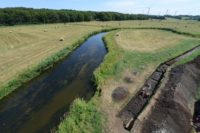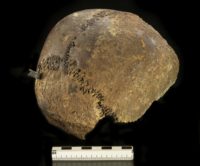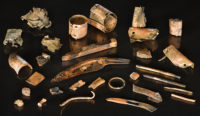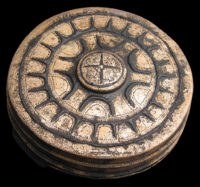Here’s a follow-up post that’s been almost a decade in coming and is all the richer from the long wait. The original story reported in 2011 was about the discovery of human, animal and material remains in the Tollense Valley of northern Germany strongly suggesting a major Bronze Age battle had taken place nearby. This was the first evidence of a battle from this period, perhaps even the earliest ever found.
 Dating to around 1200 B.C., the bones were almost all confirmed to be of young men some of whom had suffered fatal blunt and sharp-force trauma. There were no indications of formal burials — the remains appear to have been washed down to the find site from a battlefield up the Tollense River — and the remains of wooden clubs and horses found also added to the evidence of a prehistoric battle. Evidence of violent events and conflicts going back to the Stone Age has been found, but nothing like the bones of a hundred individuals, their horses and weapons.
Dating to around 1200 B.C., the bones were almost all confirmed to be of young men some of whom had suffered fatal blunt and sharp-force trauma. There were no indications of formal burials — the remains appear to have been washed down to the find site from a battlefield up the Tollense River — and the remains of wooden clubs and horses found also added to the evidence of a prehistoric battle. Evidence of violent events and conflicts going back to the Stone Age has been found, but nothing like the bones of a hundred individuals, their horses and weapons.
 Human bones had been pulled out of the Tollense River since the 1980s, most significantly a humerus with a bronze arrowhead still embedded in it found in 1996. It was that arrowhead, whose design dated it to between 1300 and 1100 B.C., that gave archaeologists the first temporal classification of the Tollense Valley remains. Later discoveries narrowed down the dates of the battlefield activity to ca. 1300-1250 B.C. The first systematic excavation of the area was done in 2008 and the first research published in 2011.
Human bones had been pulled out of the Tollense River since the 1980s, most significantly a humerus with a bronze arrowhead still embedded in it found in 1996. It was that arrowhead, whose design dated it to between 1300 and 1100 B.C., that gave archaeologists the first temporal classification of the Tollense Valley remains. Later discoveries narrowed down the dates of the battlefield activity to ca. 1300-1250 B.C. The first systematic excavation of the area was done in 2008 and the first research published in 2011.
All told, more than 12,000 pieces of human bone have been unearthed at the Tollense site, and more than 140 individuals have been identified from the bone material. They were young adult men in good general health who suffered perimortem trauma from long and short-range weapons. Some healed bone lesions indicate they were experienced fighters. Initial DNA and stable isotope analyses found some of the individuals were not local to the Tollense Valley, although it’s not clear where they came from originally.
 In 2016, a new archaeological exploration of the site discovered something unusual and highly significant: a group of 31 objects that are believed to have been the personal toolkit of a Bronze Age warrior. The artifacts were found by divers in the riverbed at the location dubbed Weltzin 28. Several bronze artifacts — tools, pins, arrowheads — had been found at this location before, but this group of bronze scrap metal pieces was packed closely together even after millennia in a river, so they must have been in a wooden container of a wrapped in a textile that has long since disintegrated.
In 2016, a new archaeological exploration of the site discovered something unusual and highly significant: a group of 31 objects that are believed to have been the personal toolkit of a Bronze Age warrior. The artifacts were found by divers in the riverbed at the location dubbed Weltzin 28. Several bronze artifacts — tools, pins, arrowheads — had been found at this location before, but this group of bronze scrap metal pieces was packed closely together even after millennia in a river, so they must have been in a wooden container of a wrapped in a textile that has long since disintegrated.
 The assemblage includes a bronze awl with a birchwood handle, a rare curved sickle knife, a chisel, bronze sheet fragments, ingot fragments, bronze scrap pieces, a star-decorated belt box of the Dabel type, three dress pins and a bronze spiral. Three bronze cylinders in the assemblage may have been the fasteners of the rotted container.
The assemblage includes a bronze awl with a birchwood handle, a rare curved sickle knife, a chisel, bronze sheet fragments, ingot fragments, bronze scrap pieces, a star-decorated belt box of the Dabel type, three dress pins and a bronze spiral. Three bronze cylinders in the assemblage may have been the fasteners of the rotted container.
Radiocarbon dating of the collection of objects demonstrates that the finds belong to the battlefield layer and they were probably the personal equipment of one of the victims. The finds were studied in a Master’s thesis by Tobias Uhlig and the new results make it increasingly clear that there was a massive violent conflict in the older Nordic Bronze Age (2000–1200 BC). In fact, recent evidence suggests that it is likely to have been on a large scale, clearly stretching beyond regional borders.
Professor Thomas Terberger, from the Department of Pre- and Early History at the University of Göttingen, says, “This is the first discovery of personal belongings on a battlefield and it provides insights into the equipment of a warrior. The fragmented bronze was probably used as a form of early currency. The discovery of a new set of artefacts also provides us with clues about the origins of the men who fought in this battle and there is increasing evidence that at least some of the warriors originated in southern Central Europe.”
The study of the recent discovery has been published in the journal Antiquity.